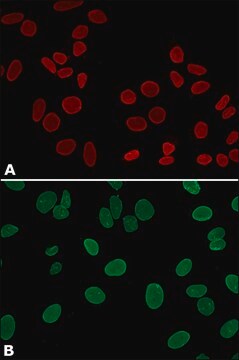일반 설명
Lamin A is a structural protein of the nuclear lamina, a meshwork of intermediate filaments that underlies the inner face of the nuclear envelope. The major components of the nuclear lamina are the lamins that may be classified into two types, A and B. Both A- and B- type lamins are characterized by an a-helical rod domain to enable assembly into filaments, a nuclear localization sequence, and a C-terminal CAAX box isoprenylation sequence for nuclear membrane targeting. A-type lamins, A and C, are produced by alternative splicing resulting in proteins of 664 and 572 amino acids, respectively. The first 566 amino acids of Lamins A and C are identical. Prelamin A, the precursor of Lamin A, has 98 unique amino acids and is farnesylated at its carboxy terminus after synthesis. The last 18 amino acids, which contain the farnesyl group, are removed by an endoproteolytic cleavage, producing the mature Lamin A. Monoclonal Anti-Lamin A/C (mouse IgG2a isotype) is derived from the hybridoma 4C11 produced by the fusion of mouse myeloma cells and splenocytes from BALB/c mice immunized with the Ig-fold domain of human Lamin A.
특이성
Mouse monoclonal clone 4C11 anti-Lamin A/C antibody recognizes human, rat, mouse, canine, hamster, monkey and bovine Lamin A/C.
면역원
hybridoma 4C11 produced by the fusion of mouse myeloma cells and splenocytes from BALB/c mice immunized with the Ig-fold domain of human Lamin A
애플리케이션
Mouse monoclonal clone 4C11 anti-Lamin A/C antibody is used to tag lamins A and/or C for detection and quantitation by immunocytochemical and immunohistochemical (IHC) techniques such as immunoblotting, immunoprecipitation, and immunofluorescence. It is used as a probe to determine the presence and roles of lamins A and/or C in nuclear envelope structure and function. This antibody may be used in several immunochemical techniques including immunoblotting (~72/63 kDa), immunoprecipitation and immunofluorescence.
생화학적/생리학적 작용
Lamins expressed in somatic cells interact with chromatin, nuclear pore complexes and integral proteins of the inner membrane of the nuclear envelope, such as LAPs 1 and 2 (lamin associated polypeptides), LBR (Lamin B receptor) and emerin. Mutations in Lamin A and C have been linked to a variety of rare human diseases including muscular dystrophy, lipodystrophy, cardiomyopathy, neuropathy and progeroid syndromes (collectively termed laminopathies) and to premature aging (Hutchinson-Gilford progeria syndrome). Lamin A is cleaved into a 47 kDa fragment during apoptosis. Lamin A cleavage seems to be essential for chromatin condensation and nuclear disassembly in apoptosis.
물리적 형태
Solution in 0.01 M phosphate buffered saline, pH 7.4, containing 15 mM sodium azide
면책조항
Unless otherwise stated in our catalog or other company documentation accompanying the product(s), our products are intended for research use only and are not to be used for any other purpose, which includes but is not limited to, unauthorized commercial uses, in vitro diagnostic uses, ex vivo or in vivo therapeutic uses or any type of consumption or application to humans or animals.










